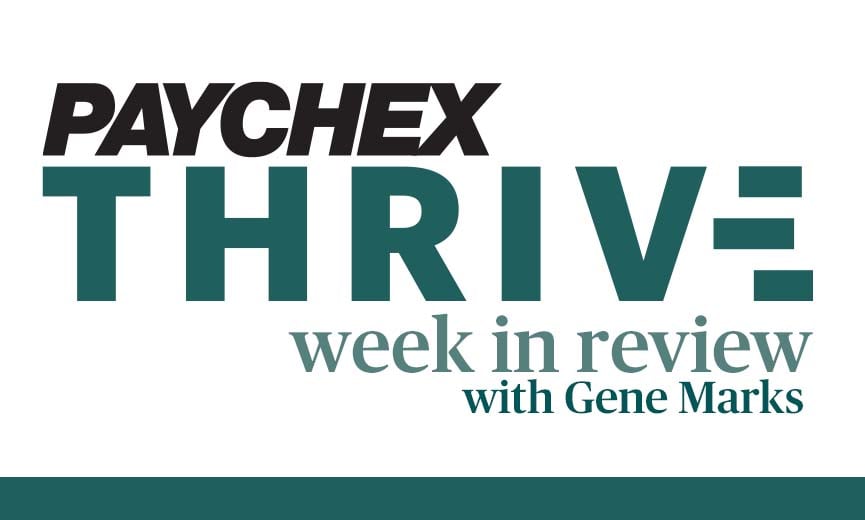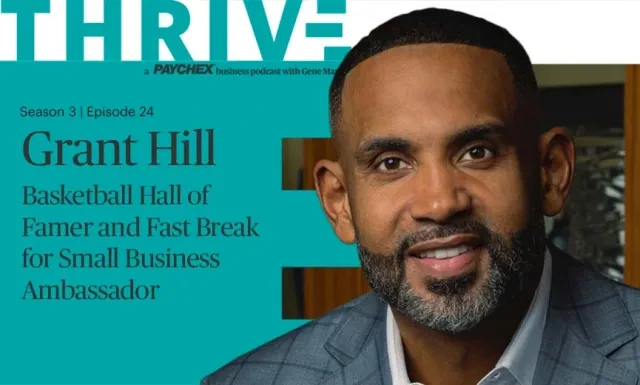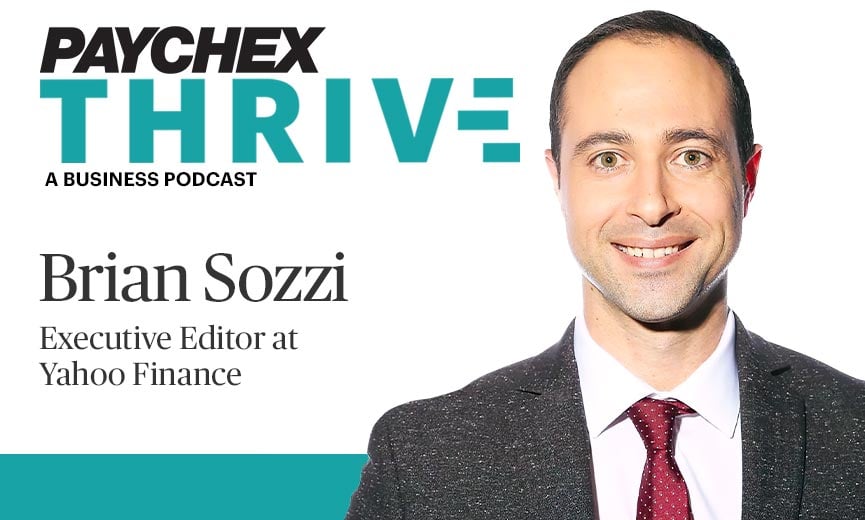Cae el aumento de las ganancias, disminuyen las ofertas de empleo y los contratos de asistencia sanitaria de proveedores directos

Podcast •

Vea
Resumen
Con todos los indicios de un mercado laboral más débil, desde un aumento de las ganancias por hora que disminuyó por debajo del 3 % por primera vez desde 2021, según Paychex Small Business Employment Watch, hasta la caída de las vacantes de empleo a las cifras previas a la pandemia, Gene Marks comparte que este podría ser un momento perfecto para que los empleadores aprovechen lo que fue un mercado de los trabajadores al sumar talento. Además, una tendencia creciente a contratar directamente a proveedores de atención médica para compensar los costos crecientes podría suponer un ahorro de dinero, pero Gene dice que también es una forma de mejorar sus esfuerzos de reclutamiento de ofertas de beneficios.
Ver transcripción
Hey everybody, it's Gene Marks and welcome back to another episode of this week's podcast Week in Review from Paychex THRIVE. This is where we take a few items in the news that impacts your business and my business, as well, and we talk a little bit about it. So, let's get right to the news, shall we?
The first actually comes from Paychex. Paychex has released their monthly Small Business Employment Watch report and there is some information that I think should be a little bit concerning. So, the report itself found that hourly earnings growth fell below 3% as job growth, however, does remain steady for U.S. businesses. Let me give you some details.
The Small Business Employment Watch for August, which reflects U.S. small businesses with fewer than 50 employees, reported hourly earnings growth for workers dropped to 2.89%. This marks the first time growth has been under 3% since January of 2021. In addition, the one-month annual hourly earnings growth dropped to 1.91%. The National Small Business Jobs Index has averaged over 100, which means it's in growth mode, through eight months of 2024, representing modest employment growth.
Let's see what John Gibson had to say. John is the CEO of Paychex. He says, “Our monthly jobs and wage report is based on actual payroll data, and provides a near real time pulse on the status of small business labor market, which can be a leading indicator of the state of the overall U.S. workforce. Our data has shown moderate changes in employment growth over the eight months in 2024, even though the jobs indexes in July and August were below 100. This supports broader trends of a cooling labor market, and the Fed's widely reported intention to begin lowering interest rates.
“Also, after holding steady for several months, hourly earnings growth continued to decelerate in August,” said John Gibson, “falling below 3% for the first time in three years. Another notable signal that the labor market is moving closer to its pre-pandemic levels.”
Now, in the Midwest, that is still remains to be the top region for small business employment, and as far as education industry and health services industry, they also continue as the top sectors for national job growth for the third consecutive month.
So, the bottom line is this job growth is definitely starting to moderate out and, in addition to that, we are also seeing hourly earnings falling below 3%. Earnings increased for the first time in a long time, and that's an annualized number.
So again, you're hiring and you're giving raises to your hourly people, you know, you're in that 3% range is where it is. But I think it is evidence of a softening labor market and we should keep that in mind as we are looking to attract talent. I mean, we don't want to see the economy soften, but at the same time as employers, it's a little helpful to know that we, there might be some more opportunity to find more employees.
Which brings me to my next bit of news. This news comes from CNBC. Job openings fell more than expected in July and another sign of labor market softening. Let me read this to you. “Job openings slumped to their lowest levels in three and a half years in July, this according to the Labor Department, which is another sign of a slack in the labor market. The department's closely watched jobs opening and labor turnover surveys showed that available positions fell to 7.67 million for the month. And that is also, after a downwardly revision from June.
“Economists were looking for 8.1 million open jobs, so job openings fell below that. With the decline, it brought the ratio of job openings per available worker down to less than 1.1, about half of where it was from its peak of more than 2 to 1 in 2022.”
According to Nick Bunker, who's the head of the economic research and Indeed Hiring Lab, he says, “The labor market is no longer cooling down to its pre-pandemic temperature. It's dropped past it. Nobody, and certainly not policymakers at the Federal Reserve, should want the labor market to get any cooler at this point.”
So again, we saw the Paychex Small Business Employment Watch data showing that hourly earnings have fallen, raises and hourly earnings had fallen below 3%, with moderate, very, very slight employment growth. And here we are seeing the number of openings for jobs fall to levels that we haven't seen since pre-pandemic times, which means the labor market is absolutely softening. And again, like I said earlier, I think it provides opportunities for us as employers to maybe find and attract and retain workers because, you know, for a while it was really a workers’ market. And now it just seems like it's more of an employer's market, or at least it's getting there and that does give us a little bit of an opportunity to find good talent.
The final story that I wanted to report to you today comes from HRdive.com and the reporting on a survey. A survey has found that employers are eager to embrace direct provider contracts for employee health coverage. Now, we all know that employee health rates, you know, for our employee benefit plans for health care are going up significantly and some areas are protecting health care costs to go up as much as 9% next year. So, a lot of employers, including myself and a lot of my clients, are looking for ways to provide affordable health care benefits while still being competitive.
Well, according to the survey, a lot of employers are going directly to health care providers. Let me let me read you a little bit from this news release. “As employers navigate rising health care expenses along with pressures to improve their employee benefits, many are considering contracting directly with health care provider organizations that have traditional health plan contracts as a way to manage costs. This practice is known as direct contracting. It's something roughly 3 in 4 employers are already doing, and another 41% are likely to consider doing it by 2025.”.
This is based on a survey that was created by a consulting firm called Brighton Health Plan Solutions of over 150 benefits executives. Direct provider contracting has become commonplace, according to the survey sample. Not only are 75% of employers already engaged in some form of direct contracting, but also more than 4 in 10 of those respondents reported managing multiple such contracts simultaneously.
So, what does this mean? Well, as we're heading into 2025 and we're looking at increasing health care costs, we're all trying to figure out a way to provide these benefits affordably and competitively. There are things like health reimbursement accounts. There are things like, HSAs, health savings accounts. Some people are going to captive insurance programs, other people are, driving, you know, just contributing less to their employees’ health care plans. There's a lot of things that employers are doing.
But clearly one big trend is a lot of employers are just directly contracting with places; hospitals, urgent care centers, direct doctors, physician networks. So that, they just basically say when you're the employee goes there, you know, we'll have a direct contracting, you know, agreement with them so we can pay for the visit or make some kind of a cost sharing with the employee, and that is less expensive than paying for the health care insurance, which covers it as well.
And it's an interesting strategy to consider, because if you directly contract with local physicians or an urgent care center and your employees who are more prone to go there, they go there. You can still get group health insurance, but, really do it for like, top-level stuff. So, there's nothing catastrophic that can happen with your employees. So, it's basically like yourself insuring for, for the basic day-to-day health care needs or problems that an employee might have, but then making sure there's insurance in place, for anything that's much bigger of a need. And that that also is an interesting strategy. And clearly a lot of employers are going there.
My name is Gene Marks and you've been watching this week's episode of the Paychex THRIVE Week in Review. I hope you found it helpful for any tips or advice or help in running your business, get our newsletter, go to paychex.com/thrive. Sign up for it. You'll get some help, as well as gaining access to prior episodes of this podcast.
I hope this information was helpful. I'll be back with you next week with some more advice to help you run your business. We'll be talking about news that affects you and me. Look forward to doing that. We'll see you in a week. Take care.
This podcast is property of Paychex, Incorporated 2024. All rights reserved.

 Apple Podcast
Apple Podcast Spotify
Spotify iHeartRadio
iHeartRadio









